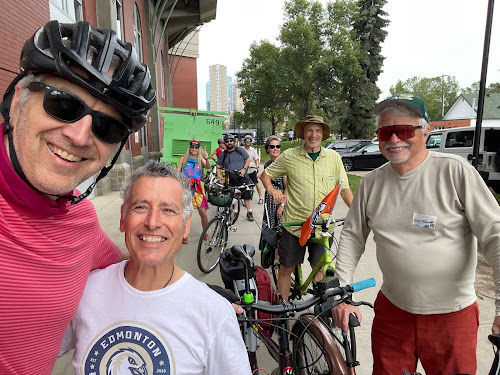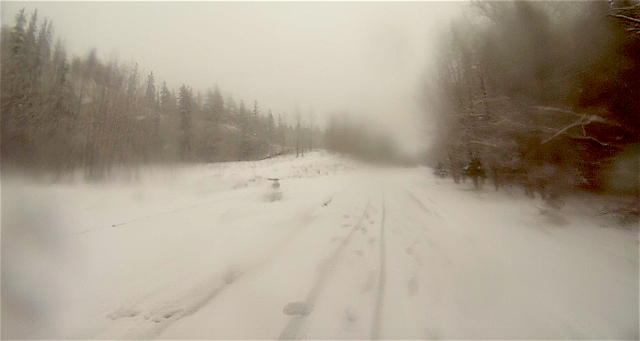Three Things from Edmonton podcast -- Episode 134: baseball, roots, body
Here are three things from the week that was that left behind tracks of happiness and gratitude.
Three Things podcast, episode 134:
1. Baseball
The pitch, the hit, the ground ball. The runner hoofs it to first base. The shortstop scoops up the ball and telegraphs it to first base—bang, bang, one out! With the ump’s signal, the crowd gets another proof that the thrown baseball eradicates space quicker than the running player. In miniature, the play at the Riverhawks game on Sunday was an episode from the history of communications technology.
It was also a routine out. For the mathematical ones scoring the game, the play is symbolized universally and beautifully as 6-3: 6 for the shortstop’s position, 3 for the first baseman’s position. Not their uniform numbers or their names, but their slots numbered 1-9 in baseball’s defensive array. Not that I was scoring the game, and not that I could see anybody else scoring the game, either. Edmonton is a baseball city, don’t get me wrong. The park we were sitting in in the river valley was where Renfrew Park opened for baseball 90 years ago. Years later it was renamed for the man who umpired the first game there, John Ducey. It has sat dormant, it’s been rebuilt, it’s been renamed. It was the home for the Triple A Edmonton Trappers. Ron Kittle hit homers there. I watched the Intercontinental Cup of Baseball there. “Cuba, si! Yanqui no!” the fans from Clareview and Hermitage chanted.
Yes, Edmonton has a baseball history, but this was a Riverhawks game. The genius of this organization is how, onto the timeless and spare elegance of the game, has been grafted a kind of personality. Personalities, really. On the public address system is broadcaster, playwright and educator Graham Neil. Between plays, Graham plays anchor to comedian, actor and improv talent Donovan Workun, who roves the stands dressed as a ball player, interviewing fans and players, giving away prizes, singing songs, telling stories, making the crowd laugh with jokes about Ardrossan and the perogy pizza at Boston Pizza—that kind of hyper local stuff.
On Sunday, Graham announced a live, breaking news bulletin from section H where Donovan had somehow identified the 100,000th fan of the season. He presented her with an Edmonton Transit bus stop sign. The crowd laughed and you could hear “he gave her a bus stop sign” roll through the stands. When Shelagh said, these guys are good, she could have been referring to a double play in the infield (6-4-3), or to a neatly tracked fly to centre field (8UA), or, just as likely, the entertaining, ad lib work of over the stadium speakers of the home-town battery.
2. Roots
A real-life question presented itself to me unexpectedly last week. I was walking along the future Valley Line West LRT line just to see what I could see. It was already dark. I saw a turnip root on the road. It was the size of a softball. Its skin was white with clouds of purple, like the sky at sunset.
If it had fallen off the turnip truck, it didn’t reveal any significant damage. Turnips are survivors. There I was on 156 Street, standing over an errant turnip, facing the real-life question: what do you do when you spot a large turnip on a city street? I picked it up, tossed it in the air and walked home with it. I reported my good luck to Shelagh, who, although almost asleep, promised to find an air fryer turnip recipe in the morning.
The next day, we peeled and cut the turnips into fries about a ½ inch thick. Then we gave them a thin coating of extra virgin olive oil and seasoned them with garlic powder, onion powder, paprika, cumin and salt. Into the air fryer basket they then went for eight minutes followed by a quick shake and five minutes more. We transferred the turnip fries to a serving plate known simply as” the gold serving plate, you know the one, with the gold pattern on it,” sprinkled them with lemon juice and enjoyed them as an evening snack. What do you do when you find a turnip on the street in west Edmonton? You trust that Lynwood girl will know what to do when you find a turnip on the street in west Edmonton.
3. Body
Is communication via Zoom as real as face-to-face communication? That’s one of the questions still with us from Covid times. Smuggled into that question is an equivalence of “real” and “in person.” I have my suspicions on that point. I’ve been in numerous face-to-face meetings where people are not present. Those meetings are more face-to-mask meetings. Sure, face-to-face encounters serve up more visual clues about whether someone is really there, but now we’re not as much talking communication as surveillance. The face-to-facers have a point, though. There is something about the body that makes for the trust needed in communication. My computer’s makers trust it’s me thanks to a biometrically informed touch key that lets me in. When I can’t use my main bodily frame to confirm my identity, when, say, I have to convince my bank over the phone that it’s me, communication is more difficult.
In Vancouver a few weeks ago, Shelagh and I walked up Robson Street for dinner. As she routinely does, Shelagh filled out a post-meal survey. As has never happened before, a stamped, hand-addressed thank you card from our server made its way through the mail to our house. It was a charming and unexpected gesture that, memo here to all direct mail marketers, has been really hard to throw into the recycling bin. I use it as a bookmark. The note has a bodily realness to it.
Don’t get me wrong. The thank you note from the waiter at Joe Fortes is not romantic poetry from Gaslight Anthem where things handwritten move from heart to limb to pen. But it’s still a bodily act. In a small way, our waiter took the time to put his body on the line. In our advanced computer-spiritual age, the body still vouches for the real. The body still matters.
Thanks for being out there, friends.










Comments
Post a Comment